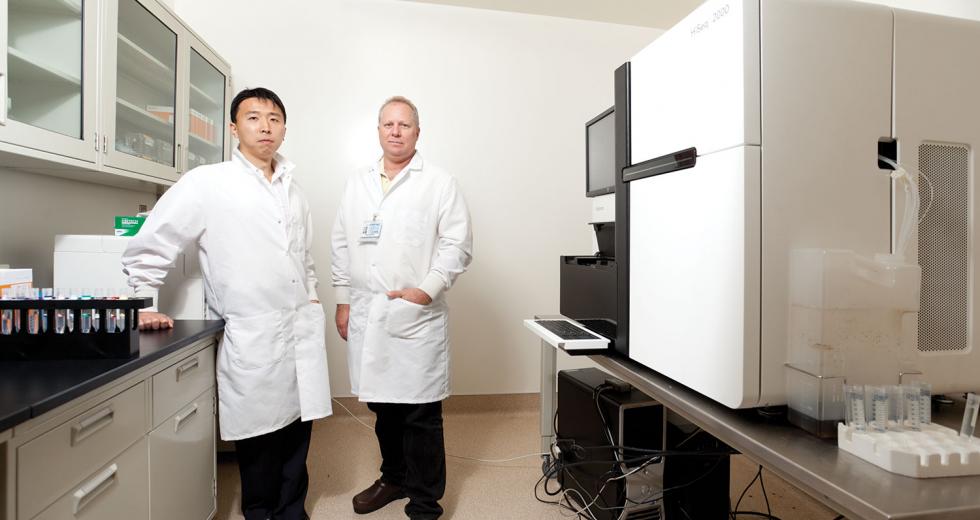At a conference in China in November 2010, Harris Lewin and Richard Michelmore approached Jian Wang, the president of global genetics company BGI, with an informal question: Could they interest the world’s largest genomics research institute in building a lab at UC Davis?
At a conference in China in November 2010, Harris Lewin and Richard Michelmore approached Jian Wang, the president of global genetics company BGI, with an informal question: Could they interest the world’s largest genomics research institute in building a lab at UC Davis?
Lewin, the university’s vice chancellor for research and a professor of evolution and ecology, and Michelmore, director of UC Davis’s Genome Center, had gotten wind BGI was looking to expand its U.S. foothold to the West Coast. They hoped that the university’s expertise in agricultural and biological research would be an unmatched selling point.
Since the race to decode the human genome began in the 1990s, the possibilities of genetic sequencing have captured public imagination. But even as the revolutionary future of personalized medicine has been slow to materialize, completed genomic maps of plants have enabled crop breeders to guide trait selection, restrain disease and improve food supplies. BGI has devoted much of its resources to tackling the premier publication of a complete genome sequence of an Asian human, and has been creating the genetic maps of rice, cucumbers, soybeans and even marijuana. It might just be persuaded to put a lab in California, America’s farming engine and technology capital, and more specifically at UC Davis.
BGI was immediately interested, and by February, “BGI@UCDavis” was up-and-running in an interim space while a 9,000-square-foot facility with a joint-investment of $15 million to $20 million began construction at the university’s School of Medicine in Sacramento.
When it is finished — likely early next year — BGI plans to furnish it with up to 20 cutting-edge machines that decode DNA samples and the people to run them. It’s a highly data- and labor-intensive undertaking, one that BGI has all but dominated, handling the process for academic researchers and pharmaceutical companies around the world.
Its partnership agreement allows UC Davis scientists priority access to BGI’s sequencing and data for its array of projects, some focusing on crops important to California, bacterial pathogens and patients undergoing chemotherapy (see sidebar). Any deeper scientific collaboration or joint ventures that develop out of these projects — and both institutions hope there will be many — would be handled independently.
The Capital Region is monitoring how BGI@UCDavis could help reenergize Sacramento’s listless biotechnology industry. Reeling from the recession, the area is starved for funding. As food issues gain urgency in the middle of the 21st century, UC Davis may see itself lead America’s efforts to drastically reduce the agricultural sector’s dependency on fossil fuels and greenhouse gas emissions.
University faculty, scientists and biotechnology executives have hailed BGI@UCDavis a landmark achievement, and City Councilman Jay Schenirer called it “a real feather in the cap for Sacramento.” The world-class center is certain to help secure millions more in research funding for UC Davis, possibly attracting companies and growing into an anchor for the Capital Region’s biotechnology industry.
“Having that first-rate genome sciences facility, having (BGI) as a partner and provider, will really accelerate the rate of discovery and our ability to compete for the most prestigious grants and federal funding,” Lewin says.
BGI, known as the Beijing Genomics Institute until it relocated its headquarters to Shenzhen in 2007, is China’s premier genome sequencing institute. Founded in 1999 by a Chinese scientist, BGI quickly demonstrated its credentials by completing a piece of the Human Genome Project, an international effort to identify all the genes present in human DNA. In recent years, the institute has embarked on an ambitious and hurried global expansion, backed by loans from a major Chinese policy bank as well as regional and scientific grants.
The company established both BGI America in Boston and BGI Europe in Copenhagen in spring 2010. Soon after, BGI America collaborated with the Children’s Hospital of Philadelphia on a new research center aimed at pinpointing genes associated with pediatric diseases.
BGI also is in partnership talks with many other private and public parties, says Hao Zhang, BGI America’s chief operating officer. “The U.S. is the most important market in the world,” and having a local presence with a lot of collaborators — both private companies and universities — to boost research is the trend of the future, he says.
Zhang won’t say how profitable BGI America is so far, only that its revenues have grown about 50 percent since 2010. But given the extraordinary cost of each DNA sequencing machine — they retail for about $500,000 each — BGI has undoubtedly invested a huge amount of money into the venture. “I have no idea what will happen in 20 years. The only thing I know is the next 20 years will dramatically change the world, so we shouldn’t let one or two dollars affect our decisions now,” Zhang says.
Initially, the partnership faced criticism from a minority of faculty concerned that a commercial entity operating on campus would adulterate the goals of an academic institution. But both Zhang and Bart Weimer, a professor in the UC Davis School of Veterinary Medicine — they are co-directors of the center — stress that the partnership is mutually advantageous and makes business sense. BGI gets access to top researchers while the university gains a world-class facility and collects rent on the space.
“A new paradigm is coming into play, and people are a little cautious of the university moving into the business world,” Weimer says.
Lewin also defends BGI’s intentions: “Their motivation is to do excellent science. They’re not in this to make money. They’re in this to establish long-term, high-profile, scientific collaborations across agriculture and human medicine,” he says.
The university also addressed these concerns “very concertedly” in the negotiations, Weimer says, by making sure Davis scientists can share as little or as much with BGI as they want. The center would be project-driven rather than staffed full time with scientists on faculty, and any excess capacity could be used to perform sequencing for third parties for profit. From an intellectual property perspective, if faculty are not interested in sharing research, they can simply purchase the lab’s genetic coding service. That is little different from what most professors already are doing, except samples no longer would need to be sent halfway around the world.
When both sides want to collaborate to jointly develop intellectual property that may eventually turn a profit — a hope attached to most sponsored research — the university would provide the resources for further negotiations, according to Lewin, who says there is “not a lot of pressure” on faculty to come forward with ideas for new businesses.
Because UC Davis is a public university, it is subject to oversight on how it manages intellectual property, to be sure no public resources benefit any private company or individual without appropriate licensing terms. Still, technology developed at UC Davis spurred the formation of seven companies last year, for a total of 40 since 2004. Royalties from licensing generated more than $11 million for the school in 2011.
That number is significant, but it’s much less than UC Berkeley generates ($95 million), and is fourth among all University of California schools. Part of the reason is that successful medical inventions are vastly more profitable, and UC Davis’ medical school is comparatively small.
But though it costs an average of $1.3 billion to get a drug to market, there are many fewer requirements for animal health, agricultural and clean energy technologies. That means future innovation in these spheres could fundamentally change peoples’ lives quicker than anyone might expect.
“I think the center signifies real interest from BGI in agriculture and the recognition that the Sacramento area is key to that,” says Eric Rey, president and chief executive of Arcadia Biosciences Inc., which researches plants’ ability to withstand drought and other stresses. Rey moved his company from Phoenix to Davis a decade ago to be closer to the ag school. “The initiative is an extremely positive development for the area, and it presents a lot of new opportunities to focus on agricultural biotechnology,” he says.
If the collaboration with UC Davis is a beachhead for BGI, the cottage industry of complex data analysis that would inevitably spring up could be a boon for the region, says prominent Sacramento developer Mark Friedman.
“What’s going to bring Sacramento out of the doldrums is the
creation of new jobs,” he says. “If we don’t create new jobs,
then there isn’t new demand for new office space. So it’s very
important that as a community we focus on sustainable jobs — jobs
that really have a natural reason to be in Sacramento.”
Pathological Library
Landmark food scares arose in 2011. Listeriosis-tainted cantaloupes were behind the deadliest known food-poisoning outbreak in the U.S. in 90 years. In Germany, a nasty antibiotic-resistant strain of E. coli in raw sprouts caused more than 40 deaths, the most lethal known international outbreak in recent history.
One project underway at BGI@UCDavis may become an important new
tool for experts during such waves of illness. It is the world’s
most ambitious effort yet to create a DNA library of pathogens.
Teaming up with the National Institutes of Health, the Food and
Drug Administration and Santa Clara-based Agilent Technologies, a
company that creates the machines necessary for this type of
science, UC Davis researchers would catalog about 100,000
microorganisms that cause disease. The hope is that detailed
looks at these pathogens would allow scientists to track
food-borne outbreaks and identify hospital-based infections
faster.
Many of these pathogens, such as E. coli, are household names.
Salmonella is the most common food-borne pathogen in the U.S.,
while methicillin-resistant Staphylococcus aureus (better known
as MRSA), a bacteria particularly impervious to antibiotics, may
be the most feared among hospital-based infections.
The project is “a really exciting, practical application of genomics to public health,” says David Lipman, director of the National Center for Biotechnology Information at the National Institutes of Health. Once the library of pathogens achieves critical mass and is made accessible in any number of ways, doctors and experts around the world could rely on it intensively as a reference tool, researchers hope.
That might mean experts can realize the big picture much quicker when outbreaks occur. Genomic methods can help doctors make a rapid connection between incidents in different locations by spotting identical pathogen early on. It’s much like forensic scientists using DNA databases to track criminals, says Lipman.
Collaborations among government, food industry, hospitals and
measurement industries permit a project of this scale to be
completed at reasonable cost. Similarly, the partnership between
professors and BGI technicians and computer scientists will be
critical to fully understanding the heaping piles of data spit
out by gene-sequencing machines. And as the cost of sequencing
continues to fall, coupled with higher instrument capacity,
ever-larger projects will be possible.
Recommended For You

Campus Construction
Projects keep the campus investing in its future
Before UC Davis played a huge role in bringing science and agriculture together and changing the course of history for California and the world, the importance of collaboration across disciplines was well recognized. That vision is perhaps nowhere better exemplified than at the campus Quad — the true heart of the campus since its founding — where the new Centennial Walk was unveiled last October.

Vision Quest
Davis seeks a plan for its future personality
Doby Fleeman can feel the ground shifting. He can almost hear the
low rumble of engines.
“The steamrollers are on the move,” says Fleeman, manager of the
Davis Ace Hardware Co. “It’s like we’re on tectonic plates.
There’s a change in the wind.”



